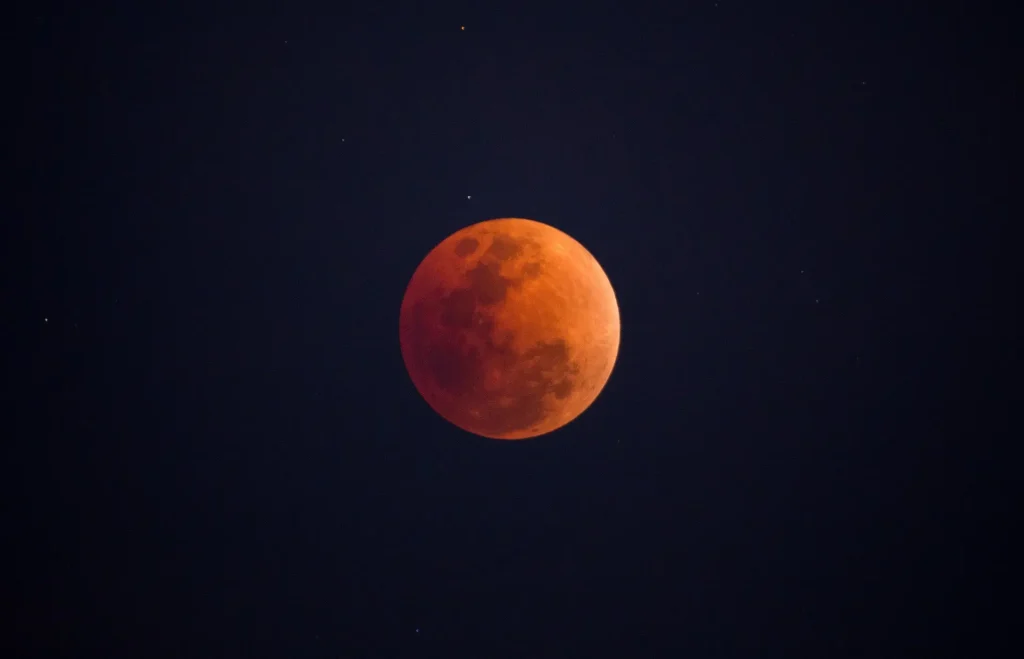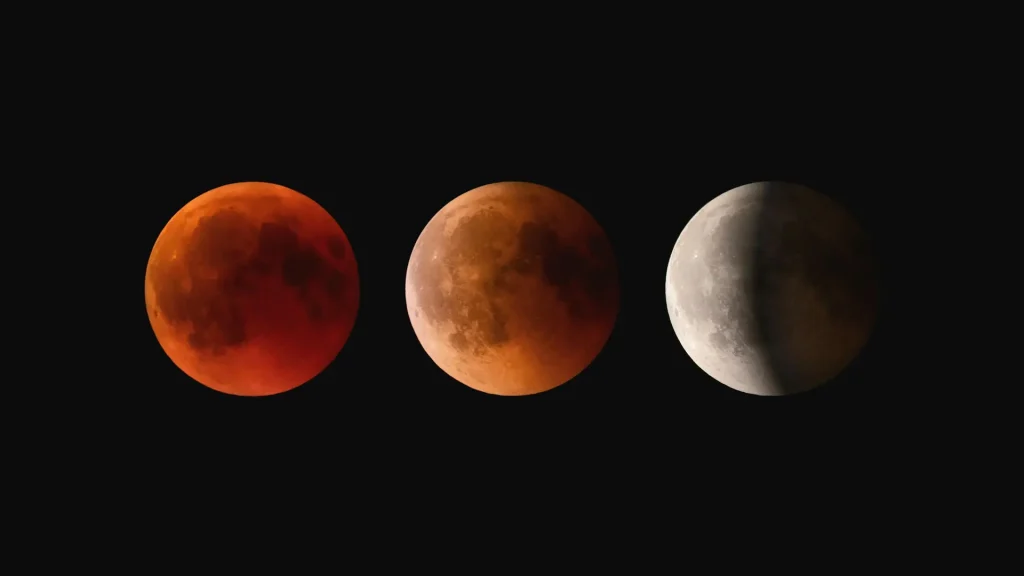The Moon has long captivated people, serving as a celestial timekeeper and a source of inspiration for myth, science, and spirituality. Among its many appearances, the Red Moon, also known as the Blood Moon, stands out for its dramatic hue and profound cultural significance.
But what causes this lunar phenomenon? Why does it hold a special place in spirituality?
In this blog post, we’re exploring the answers to those questions, as well as other interesting things about the phenomenon! 🙂

Image by theminer3746 from Pixabay
Table of Contents
What is a Red Moon?
In the terms of appearance, Red Moon (Blood Moon) basically represents a Full Moon but with a striking, reddish hue (colour).
It can only occur during that phase and a total lunar eclipse – it’s when the Earth passes directly between the Sun and the Moon. During this alignment, sunlight is filtered through the Earth’s atmosphere, scattering blue wavelengths and allowing red wavelengths to bathe the Moon’s surface. The result is a mentioned, specific reddish glow of the Moon, seen from the Earth.
The phenomenon is considered as rare – the number of Red Moon varies each year, but most often happens between 2-4 times per year.
Besides being rare, it’s a visual representation of cosmic alignment and balance; therefore offering a powerful reminder for keeping our own lives balanced and living in harmony.
Historical Symbolism and Cultural Interpretations
Below are some notable historical views and interpretations of the Red Moon.
Omen of Change and Prophecy
Ancient Babylonians tracked celestial events in great detail, interpreting lunar eclipses (and the Red Moon) as omens of change, often tied to the fate of kings or nations. These interpretations were documented in clay tablets, blending astronomy and prophecy.
In Christian eschatology, the Red Moon is mentioned in apocalyptic texts. For instance, the Book of Joel (2:31) states: “The sun will be turned to darkness and the moon to blood before the coming of the great and dreadful day of the Lord”. These references have led some to view the Red Moon as a harbinger of divine judgment or transformation.
Connection to Ancestral Spirits
Many Native American tribes, such as the Cherokee and Navajo, believed that a Red Moon symbolized a bridge to the spirit world. They performed rituals during this time, looking for guidance, protection, or blessings from ancestors.
In the Mayan tradition, a lunar eclipse was sometimes associated with jaguars, a sacred symbol, suggesting a transformative connection to the underworld.
Symbol of Conflict and War
The reddish hue of the Red Moon made ancient Greeks and Romans associate it with war, strife, or impending conflict. Roman generals sometimes delayed battles if a Red Moon appeared, believing it was a sign from the gods.
In Chinese and Korean cultures, eclipses were often viewed as celestial battles between cosmic creatures, such as dragons or celestial dogs, attempting to devour the Moon. The reddish coloration was thought to signify the Moon’s “wounding” in the fight.
Feminine Power and Fertility
In some pagan and Wiccan traditions, the Red Moon is tied to the divine feminine and the menstrual cycle, as the color red symbolizes blood and fertility. A Red Moon during a total lunar eclipse was seen as an amplified time of feminine power, creativity, and renewal. More information on the Red Moon Cycle can be found in the last part of this blog post.
Portal to Other Realms
In Hindu culture, lunar eclipses are tied to the story of Rahu, a demon who swallows the Moon in an act of vengeance. The Red Moon is seen as a result of this cosmic event, representing the temporary triumph of chaos over order. During eclipses, rituals are performed to ward off negativity and realign cosmic energies.
The Vikings believed that lunar eclipses, especially when the Moon turned red, were caused by the wolf Sköll chasing and catching the Moon. The event symbolized the ongoing battle between light and darkness in the cosmos.
A Sign of Unity in the Cosmos
Today, some see the Red Moon as a symbol of cosmic alignment and unity, representing how interconnected celestial bodies and life itself are. This perspective blends ancient reverence with contemporary scientific understanding, creating a holistic view of the phenomenon.
The Eight Phases of the Moon
Before diving into the spiritual meaning of the Red Moon, we’d like to mention the eight standard phases of the Moon:
- New Moon
- Waxing Crescent
- First Quarter
- Waxing Gibbous
- Full Moon
- Waning Gibbous
- Last Quarter
- Waning Crescent
Each phase plays a vital role in the lunar cycle, influencing everything from tides to human emotions and spiritual practices.
For a deeper dive into these phases, check out the following blog post:
The Spiritual Meaning of the Red Moon
The Red Moon carries a rich spiritual meaning:
Transformation and Rebirth
The reddish hue of the Moon symbolizes the shedding of old layers and the emergence of something new. In many traditions, it is seen as a cosmic signal for personal or collective transformation.
A Portal for Reflection
The rare alignment of a total lunar eclipse is often interpreted as a time to pause and reflect deeply on life’s patterns. It’s a moment to confront shadows, hidden emotions, or unresolved issues.
Amplified Energy
Much like a Full Moon, a Red Moon is thought to magnify energy, making it a powerful time for rituals, manifestations, or spiritual practices. The energy can feel intense, urging individuals to embrace change.
A Connection to Ancestry
Indigenous cultures, such as the Native American Cherokee or Mayan traditions, often view the Red Moon as a bridge to the ancestors. It’s a moment to honor lineage and wisdom passed down through generations.
A Warning or Prophecy
Historically, some cultures viewed the Red Moon as an omen of significant change, whether personal, political, or environmental. While modern interpretations often focus on growth and opportunity, this perspective make one wonder…

Photo by Claudio Testa on Unsplash
The Symbolism of the Red Moon Cycle
The Red Moon Cycle holds a unique place regarding spirituality and symbolism, referring to women who menstruate during the Full Moon and ovulate during the New Moon. This cycle is often seen as a powerful reversal of the more common White Moon Cycle, which aligns menstruation with the New Moon and fertility with the Full Moon.
Symbolically, the Red Moon Cycle is associated with creativity, wisdom, and inner transformation. The reddish hue of the Moon during a lunar eclipse only amplifies the transformative potential of the Red Moon Cycle; symbolizing deep personal growth, spiritual awakening, and the release of old patterns to make way for renewal.
Women in this cycle were historically considered to be healers, visionaries, or leaders, as their energy was believed to be directed outward – toward guiding, teaching, or serving the community.
Conclusion
In our age, dominated by technology and constant activity, celestial events like the Red Moon reconnect us to the natural rhythms of life. They remind us to slow down, look up, and find meaning in the grander cosmic dance.
The next time you witness a Red Moon, embrace its energy as a chance to reflect, release, and realign! ✨
More Articles
- The Pink Moon: Meaning, Magic & How It Differs from the Red Moon
- The Blue Moon: Myth, Science, and Spirituality
- Solar Flare and Its Potential Effect on Earth, Including Spiritual Side
- Angel Number 1111: A Portal of Awakening and Manifestation
